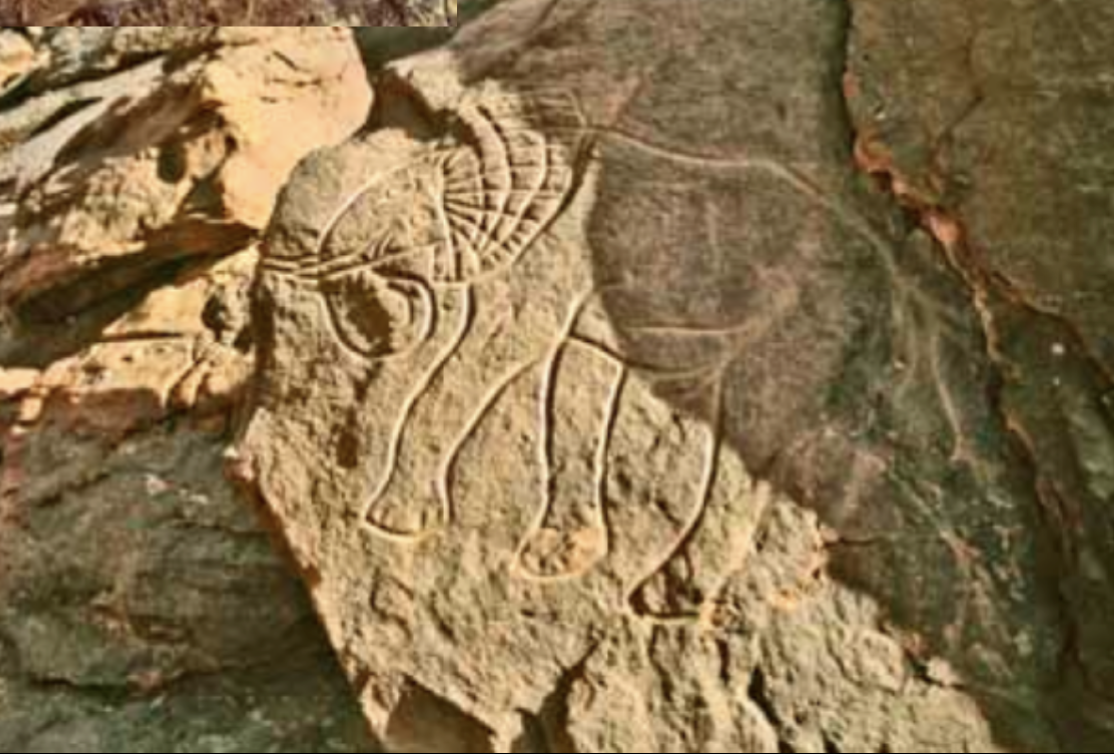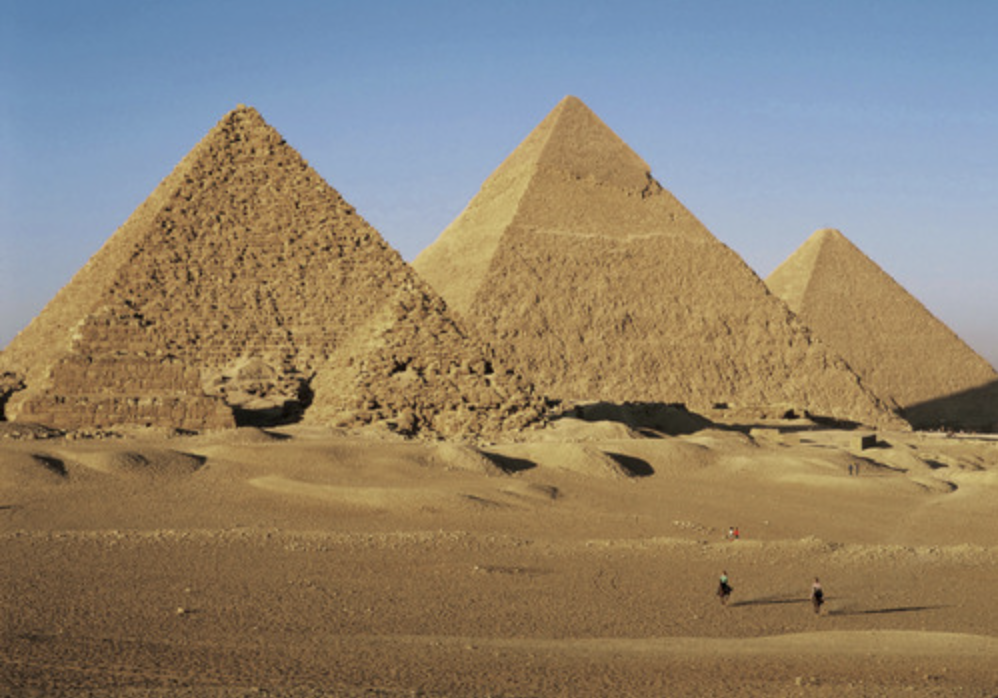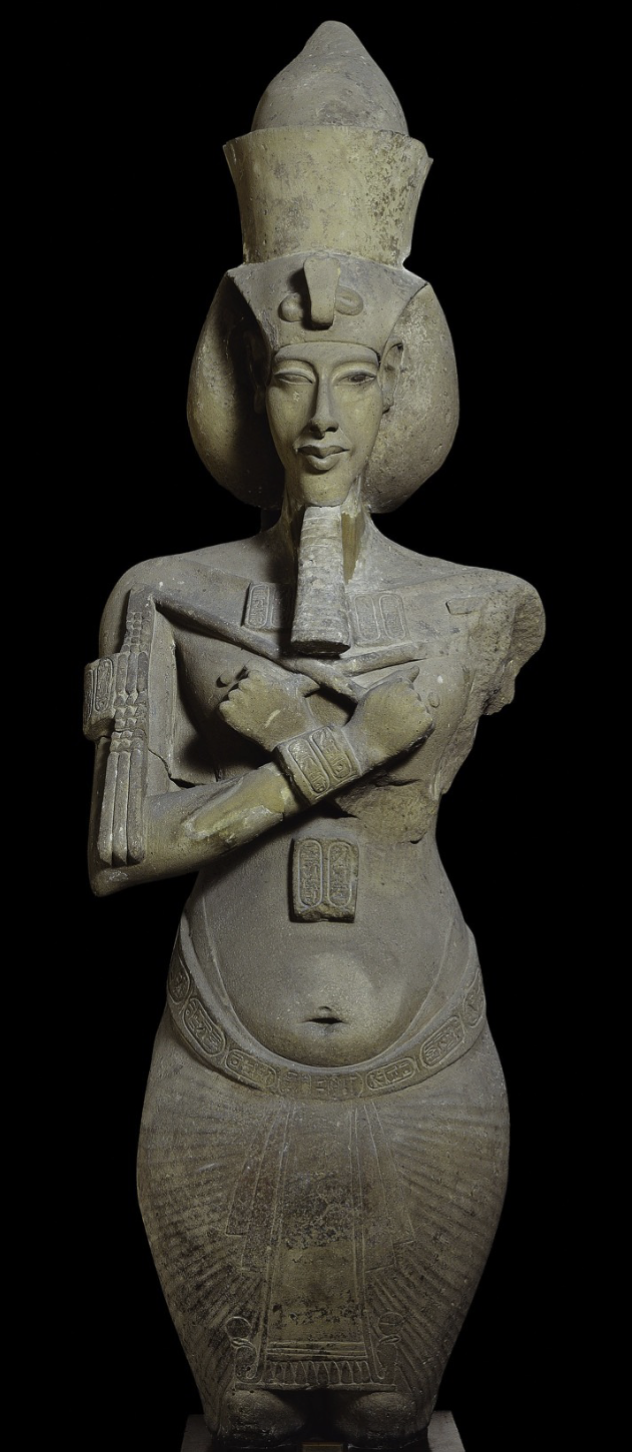African Art History Midterm (Tassili n' Ajjer, Egypt, Jenne-Jeno, Djenne, Nok, Ife, Benin, Yoruba)
1/204
Earn XP
Description and Tags
Art History
Introduction to Art History
Tassili n' Ajjer, Algeria
Prehistoric Cave Art
Pre-Dynastic Period
Old Kingdom
Middle Kingdom
New Kingdom
Amarna Period
Inland Niger Delta, Mali
Jenne-Jeno
Kingdom of Djenne
Nok, Nigeria
Nok
Ife-Ife, Nigeria
Ife
Benin, Nigeria
Kingdom of Benin
Benin Post-Exile
Yoruba, Nigeria
Yoruba
Ancient Egypt
University/Undergrad
Name | Mastery | Learn | Test | Matching | Spaced |
|---|
No study sessions yet.
205 Terms
formal analysis
analyzing what the visual components of a piece accomplish
form
components: line, shape, color, texture, mass, space, volume, & composition
line
an element the length of which is so much greater than the width that we perceive it as having only length
Actual: When the line is visible
Implied: When the movement of the viewer’s eyes over the surface of a work follows a path determined by the artist
lines can be diagonal, horizontal, curvilinear, thick, thin, etc.
shape
the two-dimensional, or flat, area defined by the borders of an enclosing outline or contour
can be geometric/regular, biomorphic/organic/irregular, closed, or open
color
includes hue, value, and saturation
hue
the exact shade of a color
value
the lightness or darkness of a hue.
High: closer to white
Low: closer to black
saturation
the quality or brightness/darkness of a hue (aka intensity)
*black and white don’t count because they are not hues*
biomorphic
describes shapes derived from organic or natural forms
geometric
normal shaped (textbook definition)
real texture
the texture of the actual surface of the artwork
i.e. fur is soft
implied texture
illusionistically described surface of objects represented in an artwork
i.e. a painting of fur looks soft
real mass
how dense an object is
implied mass
the visual mass of the artwork
space (depth)
Ways in which a 2-dimensional piece is made to look 3-dimensional
consists of: diminution, atmospheric perspective, vertical perspective, overlap, 1 and 2 point perspective, modeling, and foreshortening
diminution
the systematic de-scaling of something in the background
atmospheric perspective
things meant to be farther away appear hazy and less detailed
vertical perspective
things towards the top of the image are farther away, while things towards the bottom of the image are closer
overlap
the object on the top is closer
1 and 2 point perspective
a system of perspective that utilizes a single vanishing point and causes parts of the image to look as if they recede into the distance
modeling
making something look 3-dimensional, whether via shading or carving
foreshortening
rendering objects so they appear to recede in three-dimensional space
composition
the organization, or arrangement of forms in a work of art; how formal elements interact to create an effect/piece
realism
a *mid-nineteenth century artistic movement* characterized by subjects painted from everyday life in a naturalistic manner
representational
artwork that clearly depicts real objects
naturalism
artist’s attempts to represent the observable world in a manner that appears to describe its visual appearance accurately
idealization
strives to create images of physical perfection according to the prevailing values or tastes of a culture
abstract
art that does not represent an accurate depiction of visual reality, communicating instead through lines, shapes, colors, forms, and gestural marks
partial abstraction
features identifiable objects, people, or landscapes, but these have often been simplified, distorted, taken out of context, or rendered in non-realistic colors
full abstraction
does not draw any inspiration from visual reality
expressionism
styles in which the artist exaggerates aspects of form to draw out the beholder’s subjective response or to project the artist’s own subjective feelings
linear style
using line as the primary means of definition
painterly style
a style of representation in which vigorous, evident brushstrokes dominate, and outlines, shadows, and highlights are brushed in freely
content
artworks that communicate ideas, convey feelings or affirm the beliefs and values of their makers, their patrons, and usually the people who originally viewed or used them
Tassili n’ Ajjer, Algeria (Periods/Cultures/Kingdoms)
Prehistoric Cave Art (12,000BCE - 1,000BCE)
Archaic Style
Large Wild Fauna Period
Prehistoric Cave Art (12,000BCE - 1,000BCE) notes
encapsulates almost all of North Africa, in and around the Sahara Desert
very rocky and largely uninhabitable
teople passed through before the Great Desecration, but very few people actually lived there
there is archaeological evidence of human presence, but no architectural remains or burial sites
3 theories as to why people made paintings and carvings
Ritual Use
people may have interpreted the dramatic change of landscape as the spirit world (?)
Trade Routes
the sites could’ve been safe campsites and the paintings could be a means of communication for future travelers to warn them of dangerous animals and such
Sympathetic Magic:
when you do something like creating artwork in the hopes of affecting the real world around you
painting an elephant being killed, for example, to manifest a successful hunt
Prehistoric Cave Art (dates)
12,000BCE - 1,000BCE
Prehistoric Cave Art (location)
Tassili n’ Ajjer, Algeria
Artwork ID: “Man: Bodies in Motion”
Period: Prehistoric Cave Art (Archaic Style)
Location: Tassili n’ Ajjer, Algeria
Dates: 12,000BCE - 1,000BCE
Medium: pigment (ochre?) on sandstone

“Man: Bodies in Motion” notes
very simplified, abstracted bodies, very repetitive, doing simple motions
infrared imaging revealed multiple layers
unsure why they kept painting over one spot when other spots in the caves were available
could be a familial thing, each generation paints over the last
could be just updating information, like an animal in the area going extinct
Artwork ID: “Masked Figures”
Period: Prehistoric Cave Art
Location: Tassili n’ Ajjer, Algeria
Dates: 12,000BCE - 1,000BCE
Medium: pigment (ochre?) on sandstone

“Masked Figures” notes
we have no idea what these are quite frankly
shamanism? maybe?
Artwork ID: “Decorated Elephant Engraving”
Period: Prehistoric Cave Art (Large Wild Fauna Period)
Location: Tassili n’ Ajjer, Algeria
Dates: 12,000BCE - 1,000BCE
Medium: engraved sandstone

“Decorated Elephant Engraving” notes
large rock engravings of wild fauna
more expression, movement, and texture
fairly naturalistic, strict profiles - observational
not on cliffsides, they’re usually underneath and inside sefars
Artwork ID: “Camels and Armed People”
Period: Prehistoric Cave Art
Location: Tassili n’ Ajjer, Algeria
Dates: 12,000BCE - 1,000BCE
Medium: pigment (ochre?) on sandstone

animism
the general belief that there's a relationship between the natural world and the supernatural
composite view/pose
combining different viewpoints within a single representation
engraving
carving into something
idea vs. obeservation
cave paintings can be conceptual/descriptive (twisted perspective & exaggerated features to show the idea of reality)
they can also be strictly profile/observation (show exactly what you see)
profile view
a drawing that shows an object as though you were looking at it from the side
sefar
a rock shelter
inside sefars of the Ajjer Plateau are paintings; outside are carvings
superimposition
images were re-painted over old cave paintings
might be informational or interactive
sympathetic magic
magic based on the assumption that a person or thing can be supernaturally affected through its name or an object representing it
perhaps prehistoric people painted hunts/ bovids as a way to ensure a successful hunt
Ancient Egypt (Periods/Cultures/Kingdoms)
Period: Pre-Dynastic Period (3,000BCE - 2,700BCE)
Kingdom: Old Kingdom (2,650BCE - 2,150BCE)
Kingdom: Middle Kingdom (1,975BCE - 1,640BCE)
Kingdom: New Kingdom (1,550BCE - 1,070BCE)
Period: Amarna Period (c. 1,350BCE)
Ancient Egypt (location)
Egypt
Pre-Dynastic Period (dates)
3,000BCE - 2,700BCE
Artwork ID: “Palette of Narmer”
Period: Pre-Dynastic Period
Location: Egypt
Dates: 3,000BCE - 2,700BCE
Medium: green schist

“Palette of Narmer” notes
ceremonial, not functional
hieratic scale
sets in motion styles unique to Egypt:
iconography, upright= alive, compromised position= dying/ dead
has registers (ground lines to organize space)
Narmer seen as god descendant (not a god himself)
barefoot: Narmer on sacred ground
Old Kingdom (2,650BCE - 2,150BCE) notes
Egyptian conventions solidified (and stay consistent for another 2,000 yrs)
architecture: mastaba --> stepped pyramid --> pyramid
Old Kingdom (dates)
2,650BCE - 2,150BCE
Artwork ID: “Stepped Pyramid of Djoser”
Artist: Imhotep
Kingdom: Old Kingdom
Location: Saqqara, Egypt (necropolis of ancient Memphis)
Dates: 2,650BCE - 2,150BCE
Medium: limestone

“Stepped Pyramid of Djoser” notes
first piece with a known artist
introduces the idea of verticality
Artwork ID: “Great Pyramids of Giza”
Kingdom: Old Kingdom
Location: Giza, Egypt
Dates: 2,650BCE - 2,150BCE
Medium: limestone

“Great Pyramids of Giza” notes
Khafre, Khufu, & Menkaure
gets even more complex inside than previous burial sites to ward off grave robbers
took 20 years to build but probably should've taken 100
continues idea of verticality
maybe supposed to draw you up towards gods?
maybe geometric perfection meant to stand out?
maybe looks like the shape of Ra's sunbeams?
Artwork ID: “Seated Khafre/Khafre Enthroned”
Kingdom: Old Kingdom
Location: Egypt
Dates: 2,650BCE - 2,150BCE
Medium: diorite

“Seated Khafre/Khafre Enthroned” notes
seated in conventional way for Pharaohs' depiction
rigid = stability,
fist with scroll = intellectual
open palm = unpredictable
detached = timeless
Horus wraps wings around him (blessed by gods)
diorite: rare, hard stone that shines blue in light
blue= Horus's color
Artwork ID: “Menkaure and Queen Khamerenebty”
Kingdom: Old Kingdom
Location: Egypt
Dates: 2,650BCE - 2,150BCE
Medium: graywacke

“Menkaure and Queen Khamerenebty” notes
one foot in front of other to show figures are alive/moving forward
very rigid
unusual that the queen is shown
queen’s pose implies providing support to the pharaoh (likely)
Middle Kingdom (1,975BCE - 1,640BCE) notes
focused on surviving
lots of war/chaos/upheaval, so there's not much art
Pharaohs trying to keep Egypt above water
Middle Kingdom (dates)
1,975BCE - 1,640BCE
Artwork ID: “Head of Senusret III”
Kingdom: Middle Kingdom
Location: Egypt
Dates: 1,975BCE - 1,640BCE
Medium: yellow quartzite

“Head of Senusret III” notes
first pharaoh of the Middle Kingdom
looks more stoic, serious, and wise
the ideal is now an older, aged face
older = more experience = trustworthy leader
wrinkles, less full face, sunken eyes
the life expectancy at the time wasn’t high, so aging was a privilege
the dude with the ears
Artwork ID: “Stele of the Sculptor Userwer”
Artist: Userwer
Kingdom: Middle Kingdom
Location: Egypt
Dates: 1,975BCE - 1,640BCE
Medium: limestone

“Stele of the Sculptor Userwer” notes
first 2 registers = hieroglyphs
last 2 registers = images
the only reason Userwer had a stele is because he was a sculptor and made it for himself
common people didn’t usually have that privilege
funerary stele
manifesting taking care of the dead
regional style was very stiff
New Kingdom (1,550BCE - 1,070BCE) notes
most prosperous time in Egypt
return to tradition & more art
New Kingdom (dates)
1,550BCE - 1,070BCE
Artwork ID: “Hatshepsut Kneeling with Offering Jars”
Kingdom: New Kingdom
Location: Egypt
Dates: 1,975BCE - 1,640BCE
Medium: red granite

“Hatshepsut Kneeling with Offering Jars” notes
not holding scroll
offering jars might be a homage to the people who helped her become Pharaoh
nothing to indicate femininity, depicted as any other male pharaoh would be
had to be recovered from pieces
Thutmose III tried to erase her from history
Artwork ID: “Ramose's Brother May and his Wife Werner”
Kingdom: New Kingdom
Location: Egypt
Dates: 1,975BCE - 1,640BCE
Medium: limestone

“Ramose's Brother May and his Wife Werner” notes
Ramose was 2nd in command to Amenhotep III
“mayor” of Thebes
found in tomb of Ramose
tomb was never finished b/c Akhenaten moved the capital from Thebes to Tel-el-Amarna
lots of texture on hair/ clothes (individuality creeping into style)
space makes more sense than Middle Kingdom art
all these components show the sophistication of the New Kingdom
Artwork ID: “Innermost Coffin from Tutankhamun's Sarcophagus”
Kingdom: New Kingdom
Location: Egypt
Dates: 1,975BCE - 1,640BCE
Medium: gold with inlay of enamel and semiprecious stones

“Innermost Coffin from Tutankhamun's Sarcophagus” notes
dressed like Osiris
first untouched tomb that archaeologists found
shows return to old Egyptian tradition/ideals after whatever the fuck the Amarna period was
Artwork ID: “Last Judgement of Hu-Nefer”
Kingdom: New Kingdom
Location: Egypt
Dates: 1,975BCE - 1,640BCE
Medium: painted papyrus scroll

“Last Judgement of Hu-Nefer” notes
Hu-Nefer was a royal scribe
shows continuous narration (same figure shown in multiple times to show the story is progressing)
Osiris gets lots of visual mass and the horizontal lines point to him
Anubis (Jackel-headed god) leads Hu-Nefer to judgement area, then supervising scales
Horus (falcon-headed god) leads Hu-Nefer to Osiris (the green one)
Amarna Period (c. 1,350BCE) notes
Amenhotep III has Amenhotep IV (Amun is the traditional god of the sun; highest god)
Amenhotep IV changes his name to Akhenaten and makes Aten the new sun god, and the only god of the new religion
Akhenaten has Tutankaten
Tutankaten changes his name to Tutankhamun, moves capitol back to Thebes, and reinstates original religion/art traditions
Amarna Period (dates)
c. 1,350BCE
Artwork ID: “Akhenaten”
Period: Amarna Period
Location: Egypt
Dates: c. 1,350BCE
Medium: sandstone

“Akhenaten” notes
Nemis headdress, beard, crook & whip of Osiris stayed the same
more details in clothes and jewelry
face is very long & thin, has very defined facial features
very curvy & androgynous figure
Probably tied to Aten b/c they are genderless and Akhenaten saw himself as the physical manifestation of Aten
originally Amenhotep IV, changed to Akhenaten after coming into power
things kept from the past: beard and headdress
name means "effective on behalf of Aten"
not a god himself, but appointed by the gods (this is deviant from tradition of Pharaohs being a god)
Artwork ID: “Bust of Nefertiti”
Artist: Thutmose
Period: Amarna Period
Location: Egypt
Dates: c. 1,350BCE
Medium: painted limestone

“Bust of Nefertiti” notes
wife of Akhenaten
very well known for her beauty
name means "the beautiful one has come"
very idealized image
large eyes, long neck, small jaw
large headdress gives her head a lot of visual mass
these beauty conventions align with the standards of 20th/21st centuries
Artwork ID: “Akhenaten, Nefertiti, and Three Daughters”
Period: Amarna Period
Location: Egypt
Dates: c. 1,350BCE
Medium: sunken relief on limestone

“Akhenaten, Nefertiti, and Three Daughters” notes
depiction of the Pharaoh’s children is new
The kids look like aliens lol
curvilinear style
Akhenaten and Nefertiti are portrayed as equals
king and queen are the same size, Akhenaten isn’t in the center, facing each other, both are playing w/ the kids, 2 of the kids are facing Nefertiti, similar headdresses, Aten holds ankhs out to both of them, Nefertiti’s seat has papyrus on the sides which was only reserved for pharaohs
funerary mask
a mask that goes over the mummy's face
sarcophagus
stone box-like container for the 3 inner coffins
Nemes headdress
striped head-cloth typically worn by Pharaohs
Uraeus = protective cobra often seen on headdress of Pharaohs
ankh
symbol of life (mortal and eternal)
hypostyle hall
geometric sections that can be repeated to form a structure
in this case, pillars in a square unit that is repeated to form a hall
stele
upright tablet to communicate information
hieratic scale
a method of indicating the importance of individuals through relative size, regardless of actual dimensions
persons of lesser importance are thus depicted smaller in size in relation to their superiors
registers
scenes ordered in parallel lines
separate scenes and provide ground lines for figures